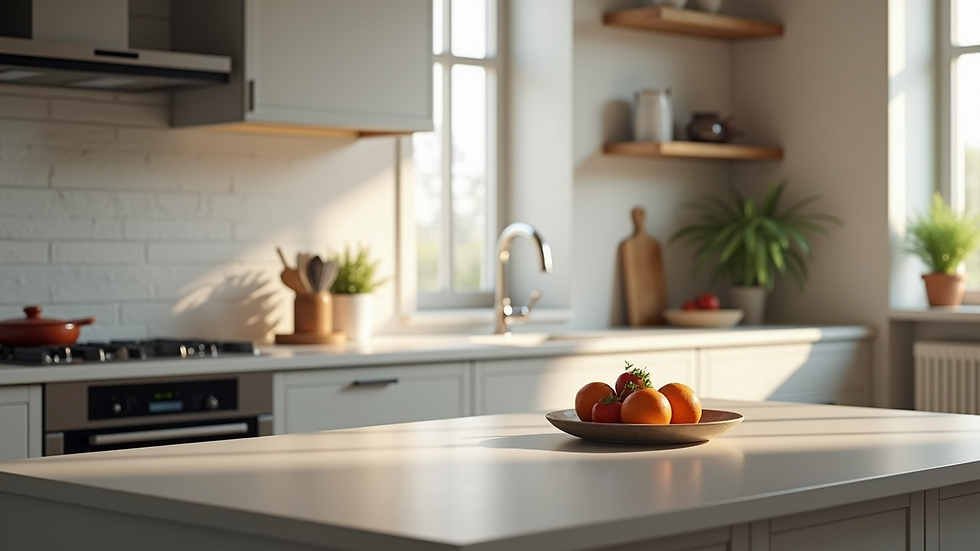Photorealistic Visualizations: Taking Designs to the Next Level
- Flomark Design
- Oct 17
- 4 min read
Updated: Oct 19
In the world of design, the ability to communicate ideas clearly and vividly is everything. Whether it’s a sleek new building, a cozy interior, or an innovative product, the way a concept is presented can make or break its success. This is where photorealistic visualizations come into play. They transform abstract sketches and blueprints into lifelike images that speak directly to the imagination. But what exactly makes these visualizations so powerful? And how can they elevate your projects beyond expectations?
Unlocking the Power of Photorealistic Visualizations
Imagine walking through a building that hasn’t been built yet. You can see the sunlight streaming through the windows, feel the texture of the materials, and sense the flow of the space. This immersive experience is the magic of photorealistic visualizations. They are not just pretty pictures; they are detailed, accurate representations that bring designs to life with stunning clarity.
The power lies in their ability to bridge the gap between concept and reality. For architects, interior designers, product manufacturers, and real estate developers, this means fewer misunderstandings, faster approvals, and more confident decision-making. When clients see a design rendered with such precision, they don’t have to guess what the final product will look like. They know.
Photorealistic visualizations also allow for experimentation without risk. Want to test different materials, lighting conditions, or layouts? These images can be adjusted quickly and cost-effectively, saving time and resources during the design process.

How Photorealistic Visualizations Enhance Communication and Marketing
Clear communication is the backbone of any successful project. Photorealistic visualizations serve as a universal language that transcends technical jargon and complex drawings. They speak directly to the senses, making it easier to convey the essence of a design to stakeholders, investors, and end-users.
From a marketing perspective, these visualizations are invaluable. High-quality images can be used in brochures, websites, and presentations to attract buyers and investors. They create an emotional connection by showcasing the lifestyle and experience a space or product offers. This emotional pull often translates into faster sales and stronger brand loyalty.
Consider a real estate developer showcasing a new residential complex. Instead of relying on floor plans and artist sketches, they present photorealistic images that highlight the building’s architecture, landscaping, and interior finishes. Potential buyers can virtually explore the property, envisioning themselves living there. This immersive preview builds trust and excitement.

Can ChatGPT Do Architectural Renderings?
This question often comes up as AI tools become more sophisticated. While ChatGPT excels at generating text-based content, ideas, and even code, it does not create architectural renderings or photorealistic images. The creation of such visualizations requires specialized 3D modeling software and artistic expertise.
However, ChatGPT can assist in the visualization process by helping draft project descriptions, marketing copy, or technical documentation that complements the visual content. It can also guide users on best practices for commissioning or creating photorealistic renderings.
For actual photorealistic architectural visualization, partnering with experts who specialize in 3D rendering is essential. These professionals combine technical skill with artistic vision to produce images that are not only accurate but also compelling.
Practical Tips for Leveraging Photorealistic Visualizations in Your Projects
To maximize the benefits of photorealistic visualizations, consider these actionable recommendations:
Start Early in the Design Process
Integrate visualization early to identify potential design issues and explore alternatives before construction begins.
Focus on Realism and Detail
Pay attention to lighting, textures, and materials. The more realistic the image, the more persuasive it will be.
Use Multiple Perspectives
Provide various angles and close-ups to give a comprehensive understanding of the design.
Incorporate Context
Show the design within its environment to help viewers grasp scale and surroundings.
Collaborate with Skilled Visualizers
Work with professionals who understand both design and rendering technology to ensure quality results.
Leverage Visualizations for Stakeholder Engagement
Use images in presentations and marketing materials to build enthusiasm and secure buy-in.
By following these steps, you can harness the full potential of photorealistic visualizations to streamline your workflow and enhance project outcomes.

Bringing Your Vision to Life with 3D-Visionaries
When it comes to creating stunning 3D visualizations, partnering with the right team makes all the difference. At 3D-Visionaries, the focus is on delivering exceptional clarity and detail that breathe life into your architectural, interior design, and product concepts. Their expertise in photorealistic architectural visualization ensures that every project is presented with precision and artistry.
Imagine having a trusted partner who understands your vision and translates it into images so vivid, they feel tangible. This collaboration not only enhances communication but also accelerates decision-making and marketing efforts. With 3D-Visionaries, your designs don’t just exist on paper - they come alive in ways that inspire and captivate.
The future of design is visual. Embrace the power of photorealistic visualizations and watch your projects reach new heights of success.
Transform Your Vision with 3D Visionaries
At 3D Visionaries, we bring your architectural ideas to life through cutting-edge visualization solutions. Whether you need real-time rendering, immersive VR experiences, or AI-enhanced visual storytelling, our team helps you communicate your vision with clarity and impact.



Comments